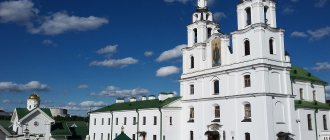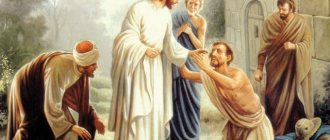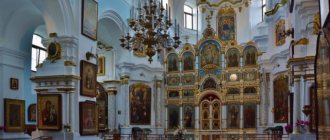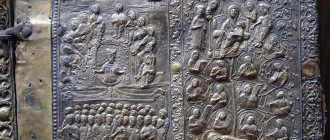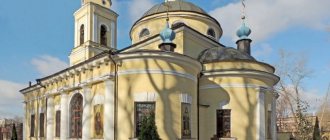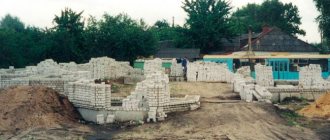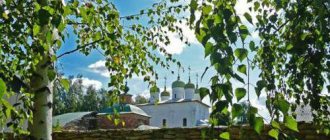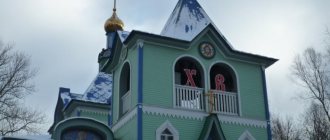- Full name: Church of the Descent of the Holy Spirit at the Danilovskoye Cemetery
- Short names among the people: Temple of the Spirits / Temple of the Holy Spirit, Church of the Holy Spirit, Temple of the Descent on Danilovsky, temple at the Danilovsky Cemetery
- Belongs to the Southern Vicariate, Danilovsky Deanery
- Rector: Archpriest Gennady (Borozdin)
- Famous clerics: Father John (Slugin), who had the gift of clairvoyance. Died February 2, 2021
- Nearest metro station: Tulskaya
- You can order services: funeral service, memorial service, magpie, notes of repose
The temple was built in the 30s. XIX century according to the project of the architect. F. M. Shestakova in the style of classicism. During the years of Soviet power it was not closed, which is why Blessed Matrona of Moscow bequeathed to bury herself at the Danilovsky cemetery. The church operates a Sunday school, a library, an Orthodox creative studio, a children's puppet theater, and a service for helping those dependent on drug addiction and alcoholism.
How to get to the temple at the Danilovsky cemetery:
Public transport:
by metro: from the Tulskaya metro station by tram route 38 and buses routes 121, 41 and 826.
By car:
from the Third Transport Ring: exit on Dukhovskaya lane leading to the necropolis.
Telephone
8
In the church you can submit requests and hold services for seriously ill people and those near death:
- unction
- confession
- communion at home, in hospital
Funeral Orthodox set:
A funeral veil (shroud), a halo on the head, a pectoral cross, a cross in the hand, a piece of paper with a prayer of permission, an eight-pointed gravestone cross.
The city ritual service “Your Ritual” will help you order requirements and services when organizing a funeral:
- Funeral service in church and at home, funeral service in absentia
- Memorial service
- Sorokoust
- Notes of repose
Prices for funerals in Moscow and the Moscow region
More details
Funeral service in church - average donation size
According to an established tradition, a feasible voluntary donation is made for the funeral service - usually in the amount of 2-5 thousand rubles.
Memorial service in the temple - donation amount
usually up to 500 rubles.
Story
At the end of the eighteenth century, a terrible plague came to the capital. The infection appeared in the Lifortovo hospital. Up to a thousand people began to die from this disease every day. People were in panic, the authorities did not know what to do. Empress Catherine the Second sends Count Orlov to Moscow with unlimited powers. Departments had to obey him unquestioningly.
The count issued a special order to open several burial sites far from the capital. One of them was the territory of the former Danilovsky Monastery, hence the name Danilovskoye. Famous merchants, townspeople, artisans and other famous people were buried there. The merchant family of the Tretyakovs, the founders of the Tretyakov Gallery, Blessed Matrona and Metropolitan Piritima found their final refuge here.
In the late nineties, the remains of St. Matrona were moved to the Intercession Church, but people come to the grave nowadays and bring her favorite chrysanthemum flowers. A small wooden temple was also built for the needs of the population. Over time, this building fell into disrepair after fifty years and a new church made of stone was erected with the funds of the merchants Solodovnikov, Golofteev, Zubov and Lepeshkin.
The best article for you, go to: Church of the All-Merciful Savior in Mitino, schedule of services
The architect was the famous in his time Shestakov, an adherent of Russian classicism, he had a light hand, all his buildings have been preserved to this day.
At the beginning of the twentieth century, the church was transformed. It had a floor covering made of multi-colored slabs, and the altar had a parquet floor. The temple has a happy destiny; it was not closed during the period of pressure on believers of the last century. But after the revolution of the seventeenth year, gold and silver church decorations were requisitioned from it.
Clergy
Abbots
- …
- Nikita Skvortsov (1857 - ca. 1892)
- Vladimir Ostroukhov (1901 - 1914)
- Nikolai Skvortsov (August 9, 1914 - June 15, 1917)
- Ilya Gumilevsky (1922 - ?)
- Sschmch. Ioann Smirnov (1925 - 1932)
- Ioann Mazov (June 14, 1991 - August 23, 1994)
- Sergiy (Rybko) (since 1994)
1932 - 1991 - closure and desecration
Priests
- Alexy Mirolyubov (1901 - 1917)
- Alexy Sokolov (1901 - 1917)
- Alexander Sokolov (1909 - 1917)
- Sschmch. Ioann Smirnov (1923 - 1925)
- Alexy Strakhov (1921 - 1927)
- Alexey (mentioned ca. 1927)
Deacons
- Dimitry Rumyantsev (1901 - 1917)
- Alexy Saryevsky (1913 - 1917)
- Feodor Smirnov (November 16, 1917 - 1932)
- John Ovsyanko (1927) protodeacon
- Mikhail Pirogov (1927) protodeacon
LiveInternetLiveInternet
An entire period in Talashkin’s life is associated with the name of Nicholas Roerich. One of his best monumental creations has survived to this day - the magnificent mosaic “The Savior Not Made by Hands,” made by the artist over the portal of the Church of the Holy Spirit.
The construction of the temple in Flenovo began in 1902. The artist S.S. took part in the creation of the project. Malyutin, connoisseur of antiquities and art I.F. Barshchevsky and the owner of the estate M.K. Tenisheva.
The construction of the church was largely completed in 1905. Since 1903, the Russian artist and philosopher Nicholas Roerich often came to the estate. In 1908, he took up paintings and smalt mosaics in the Church of the Holy Spirit. The artist managed to finish (the work was interrupted due to the outbreak of the First World War) the frescoes of the altar, painted one of the entrance arches and decorated the main entrance to the church with a large mosaic panel “The Savior Not Made by Hands”.
This neo-Russian style church, according to its creators, was supposed to serve as the tomb of the Tenishevs.
The church building gives the impression of a monumental structure. From a wide base of small height, the composition moves to dynamic and fractional forms of kokoshniks rising in rows. At the very top of the temple there is an onion dome. The revival of the kokoshnik motif is not accidental. The artists searched in the direction of reviving ancient Russian traditions, restoring original Russian forms that, in their opinion, were lost in the 17th century.
N. Roerich dedicated many of his inspired works to the image of the Savior Not Made by Hands. Mosaics made according to his sketches decorated many temples. But nowhere does the Image of Christ the Savior achieve such power as in the mosaic above the entrance to the Church of the Holy Spirit in Talashkino, the estate of Princess M.K. Tenisheva.
Maria Klavdievna considered the construction of this temple to be a holy work for herself, and when, at her request, Roerich agreed to do the decoration of the temple, she was simply happy.
Already from afar, when approaching the temple, this picture of amazing beauty and power catches your eye. Almost its entire space is occupied by the Face of Christ on a white board, surrounded by flying Angels, and above, above the clouds, the Unearthly City is visible, completing the entire composition.
We see a noble Face - high arched eyebrows, wide open, straight-looking eyes. The mighty power of a piercing gaze, in which boundless sorrow and boundless compassion are combined, makes the Face alive, bringing the high spiritual Origin closer to our heart.
Savior Not Made by Hands. Sketch of the mosaic above the portal of the Temple of the Holy Spirit in Talashkino. 1910 Roerich. Smolensk State Museum-Reserve
This work was made in mosaic by the talented mosaic artist Frolov in 1912. Mosaic was one of Roerich's favorite materials. He considered it the best form of high art.
Throne of the Invisible God (sketch for painting) 1909
Queen of Heaven above the River of Life.
In general, the artistic design of the Church of the Holy Spirit became a significant event in the life of the artist. It was here that Nikolai Konstantinovich managed to realize his most secret plans.
N.K. Roerich. Queen of Heaven. 1911
Sketch of a mural for the Church of the Holy Spirit in
Collection of Joe Jagoda. USA. Dallas
Judging by the descriptions of contemporaries, the painting was unusually colorful, bright, shimmering with all shades of paint. The artist depicted the Mother of God herself - as the source of the Supreme Light - in silver-white tones, with pink and gold.
In the Church of the Descent of the Holy Spirit in Talashkin in the past
What was the main idea of the temple? As N.K. Roerich wrote, “the central place in it should have been occupied by the image of the Mother of the World.” The composition of the altar part - “The Queen of Heaven over the River of Life” - was originally conceived by the artist as the embodiment of the image of the Mother of the World, the great Feminine Principle, revered not only in Rus'.
At the Church of the Descent of the Holy Spirit now
Unfortunately, the murals of the Church of the Holy Spirit have not been preserved and an idea of it can only be formed on the basis of sketches and photographs of those years. In Soviet times there was a grain warehouse here.
The media reported that in the future, N.K.’s painting will be restored from the surviving fragments. Roerich's "Queen of Heaven above the River of Life", which once adorned the altar wall of the temple. The artist’s son, the famous painter S.N., spoke about the need to restore it in the 80s of the last century. Roerich.
Due to the non-canonical views of the founders of the church in Talashkino on Christianity, the Temple of the Spirit was never consecrated by the Orthodox Church. The idea of the unity of all religions and numerous deviations in the artist’s paintings were not supported by the Synod. The church remained unconsecrated.
As you know, in 2021 the temple was repaired at the expense of the federal budget (as was the mosaic work in 2017).
The restoration of the Roerich mosaic, as well as the revitalization of the estate occupied by the temple (repairing the road, laying paving stones, clearing the territory) gives hope that in the future the problems that impede the full functioning of this unique cultural monument in Russia will be eliminated.
Prince Tenishev, who died in 1903 in Paris, was buried in the crypt of the unfinished Church of the Holy Spirit. 15 years later, the “liberated people” violate the scientist’s ashes. The body of the deceased will be pulled out of the coffin, “sat” in a chair and a newspaper will be thrust into the dead hands. Then they will bury it in a rural churchyard. Now the grave of V.N. Tenishev is lost.
Near the Church of the Holy Spirit in Flenov only a cross was erected in memory of V.N. Tenishev.
Prince Vyacheslav Nikolaevich Tenishev (1844 - 1903), a major industrialist and scientist, financed the activities of his wife M.K. Tenisheva, being a co-owner of the Bryansk Machine-Building Plant.
Seriously interested in ethnographic research, Prince V.N. Tenishev wrote and published in Smolensk “A Program of Ethnographic Information about the Peasants of Central Russia,” which is of scientific value in our time.
In St. Petersburg he founded the best commercial school in Russia.
https://gallery.facets.ru/show.php?id=797
https://test.kristinaartgallery.ru/SPORUChNICA_GREShNYH
https://sobory.ru/article/?object=03165
https://kraeved1147.ru/talashkino-flenovo/
https://arbatovagidepar.livejournal.com/1855165.html
